Indexed in: ESCI, Scopus, PubMed,
PubMed Central, CAS, DOAJ, KCI
PubMed Central, CAS, DOAJ, KCI
FREE article processing charge

Previous issues
- Page Path
- HOME > Browse Articles > Previous issues
Imagery
- "Bountiful autumn fields in Korea"
- J Yeungnam Med Sci. 2022;39(4):i. Published online April 27, 2022
- DOI: https://doi.org/10.12701/jyms.2022.00269

- 2,179 View
- 43 Download
Review articles
- Optogenetic neuromodulation with gamma oscillation as a new strategy for Alzheimer disease: a narrative review
- Haneol Ko, Sang-Pil Yoon
- J Yeungnam Med Sci. 2022;39(4):269-277. Published online February 14, 2022
- DOI: https://doi.org/10.12701/jyms.2021.01683
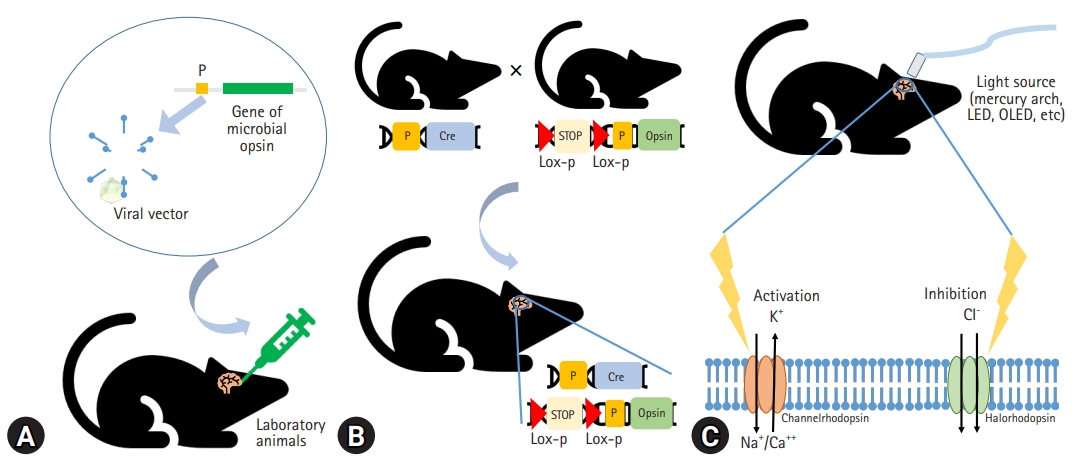
- 6,076 View
- 124 Download
- 3 Web of Science
- 4 Crossref
-
 Abstract
Abstract
 PDF
PDF - The amyloid hypothesis has been considered a major explanation of the pathogenesis of Alzheimer disease. However, failure of phase III clinical trials with anti-amyloid-beta monoclonal antibodies reveals the need for other therapeutic approaches to treat Alzheimer disease. Compared to its relatively short history, optogenetics has developed considerably. The expression of microbial opsins in cells using genetic engineering allows specific control of cell signals or molecules. The application of optogenetics to Alzheimer disease research or clinical approaches is increasing. When applied with gamma entrainment, optogenetic neuromodulation can improve Alzheimer disease symptoms. Although safety problems exist with optogenetics such as the use of viral vectors, this technique has great potential for use in Alzheimer disease. In this paper, we review the historical applications of optogenetic neuromodulation with gamma entrainment to investigate the mechanisms involved in Alzheimer disease and potential therapeutic strategies.
-
Citations
Citations to this article as recorded by- Modulating Proteasome Function with Polyphenol Metabolites: A Promising Therapeutic Avenue for Alzheimer's Disease
Nyerovwo Charity Okei
European Journal of Medical and Health Research.2024; 2(2): 16. CrossRef - A comprehensive review of optical fiber technologies in optogenetics and their prospective developments in future clinical therapies
Siyu Chen, Zhuo Wang, Kun Xiao, Benzhao He, Jing Zhao, Xin Yang, Qingqing Liu, Anuj K. Sharma, Arnaldo Leal Junior, Rui Min
Optics & Laser Technology.2024; 179: 111332. CrossRef - Exogenous AMPA downregulates gamma-frequency network oscillation in CA3 of rat hippocampal slices
Chengzhang Li, Zhenrong Li, Sihan Xu, Sanwei Jiang, Zhenli Ye, Bin Yu, Shixiang Gong, Junmei Li, Qilin Hu, Bingyan Feng, Mengmeng Wang, Chengbiao Lu
Scientific Reports.2023;[Epub] CrossRef - Light-Controlled Modulation and Analysis of Neuronal Functions
Carlo Matera, Piotr Bregestovski
International Journal of Molecular Sciences.2022; 23(21): 12921. CrossRef
- Modulating Proteasome Function with Polyphenol Metabolites: A Promising Therapeutic Avenue for Alzheimer's Disease
- Pediatric headache: a narrative review
- Saeyoon Kim
- J Yeungnam Med Sci. 2022;39(4):278-284. Published online September 14, 2022
- DOI: https://doi.org/10.12701/jyms.2022.00528
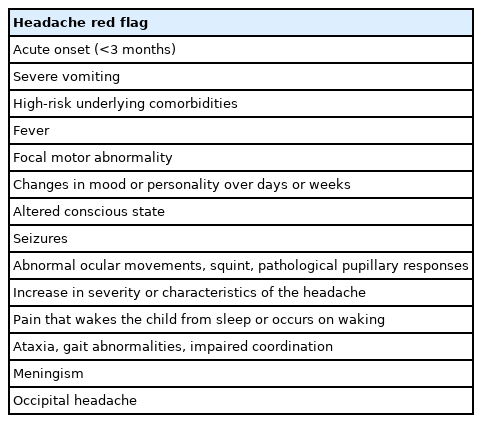
- 4,301 View
- 137 Download
- 3 Web of Science
- 3 Crossref
-
 Abstract
Abstract
 PDF
PDF - Headache is one of the most common neurological disorders in children and adults and can cause significant distress and disability in children and their families. The spectrum of pediatric headaches is broad, and the underlying etiology is variable. The symptoms and phenotypes of headaches in children may differ slightly from those in adults. It is important to have a good understanding of headaches in children and to distinguish between primary and secondary headaches through appropriate history assessment and neurological examination. Accurate diagnosis and appropriate drug selection are helpful for effective treatment. This article reviews headaches in children and adolescents, focusing on approaches for diagnosis and management.
-
Citations
Citations to this article as recorded by- Exploring downstream effects of gender roles in healthcare decision-making and relationships within systems: A cross-sectional analysis of openness to treatment in pediatric headache
Zoë Schefter, Allison M. Smith
Journal of Psychosomatic Research.2024; 179: 111611. CrossRef - Occipital nerve stimulation in pediatric patients with refractory occipital neuralgia
James Mossner, Nour B. Saleh, Maryam N. Shahin, Joshua M. Rosenow, Jeffrey S. Raskin
Child's Nervous System.2024; 40(8): 2465. CrossRef - Multivariate prediction of long COVID headache in adolescents using gray matter structural MRI features
Minhoe Kim, Sunkyung Sim, Jaeseok Yang, Minchul Kim
Frontiers in Human Neuroscience.2023;[Epub] CrossRef
- Exploring downstream effects of gender roles in healthcare decision-making and relationships within systems: A cross-sectional analysis of openness to treatment in pediatric headache
Original articles
- Age-related low skeletal muscle mass correlates with joint space narrowing in knee osteoarthritis in a South Korean population: a cross-sectional, case-control study
- Hyun-Je Kim, Young-Hoon Hong
- J Yeungnam Med Sci. 2022;39(4):285-293. Published online February 3, 2022
- DOI: https://doi.org/10.12701/jyms.2021.01536
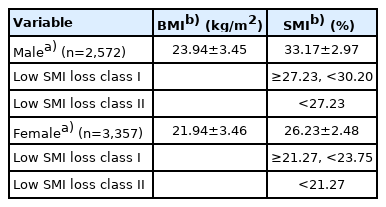
- 4,064 View
- 86 Download
- 2 Web of Science
- 1 Crossref
-
 Abstract
Abstract
 PDF
PDF - Background
This study was conducted to analyze the effects of low skeletal muscle mass index (SMI) and obesity on aging-related osteoarthritis (OA) in the Korean population.
Methods
A total of 16,601 participants who underwent a dual-energy X-ray absorptiometry and 3,976 subjects with knee X-rays according to the modified Kellgren-Lawrence (KL) system were enrolled. Knees of ≥KL grade 2 were classified as radiologic OA. The severity of joint space narrowing (JSN) was classified by X-rays as normal, mild-to-moderate, and severe JSN in radiologic OA. The subjects were grouped as normal SMI (SMI of ≥–1 standard deviation [SD] of the mean), low SMI class I (SMI of ≥–2 SDs and <–1 SD), and low SMI class II (SMI of <–2 SDs). Obesity was defined as a body mass index (BMI) of ≥27.5 kg/m2.
Results
The modified KL grade and JSN severity were negatively correlated with the SMI and positively correlated with BMI and age. The SMI was negatively correlated with age. JSN severity was significantly associated with a low SMI class compared to a normal SMI, which was more prominent in low SMI class II than class I. Obesity was significantly associated with more severe JSN, only for obesity with a low SMI class. Furthermore, patients with a low SMI class, regardless of obesity, were prone to having more severe JSN.
Conclusion
This study suggested that a low SMI class was associated with aging and that an age-related low SMI was more critically related to the severity of JSN in OA. -
Citations
Citations to this article as recorded by- Causal relationship between sarcopenia and osteoarthritis: a bi-directional two-sample mendelian randomized study
Jiyong Yang, Peng Liu, Shuai Wang, Tao Jiang, Yilong Zhang, Wengang Liu
European Journal of Medical Research.2023;[Epub] CrossRef
- Causal relationship between sarcopenia and osteoarthritis: a bi-directional two-sample mendelian randomized study
- Intensive care unit management of uncomplicated type B aortic dissection in relation to treatment period: a retrospective observational study
- Chul Ho Lee, Jae Seok Jang, Jun Woo Cho
- J Yeungnam Med Sci. 2022;39(4):294-299. Published online February 10, 2022
- DOI: https://doi.org/10.12701/jyms.2021.01690
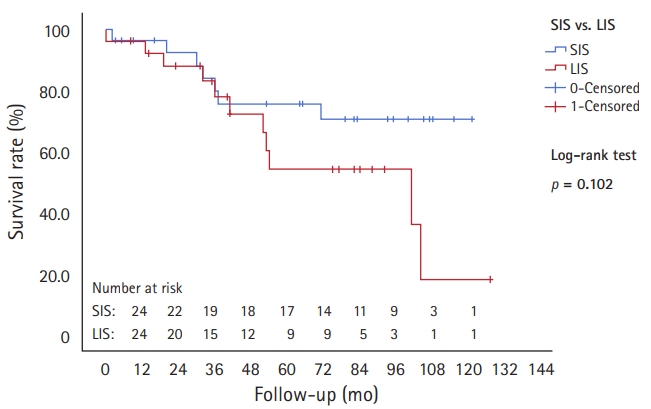
- 3,626 View
- 62 Download
-
 Abstract
Abstract
 PDF
PDF - Background
Medical therapy is the standard treatment for uncomplicated acute type B aortic dissection (ATBAD), but there is little evidence of the need for intensive care unit (ICU) management. Therefore, we aimed to investigate the effects of ICU treatment on uncomplicated ATBAD.
Methods
We retrospectively studied patients with uncomplicated ATBAD who were medically treated between January 2010 and July 2020. Patients were divided into long-term ICU stay (LIS) and short-term ICU stay (SIS) groups, according to a 48-hour cutoff of ICU stay duration. The incidence of pneumonia and delirium, rate of aortic events, hospital mortality, and survival rate were compared.
Results
Fifty-five patients were treated for uncomplicated ATBAD (n=26 for LIS and n=29 for SIS). The incidence of pneumonia (7.7% vs. 3.6%) and delirium (34.6% vs. 14.3%) was higher in the LIS group than in the SIS group, but the differences were not statistically significant. The survival rates at 1, 3, and 5 years were not different between the two groups (LIS: 96.2%, 88.0%, and 54.2% vs. SIS: 96.4%, 92.2%, and 75.5%, respectively; p=0.102). Multivariate Cox regression analysis for aortic events showed that using a calcium channel blocker lowered the risk of aortic events.
Conclusion
Long-term ICU treatment is unlikely to be necessary for the treatment of uncomplicated ATBAD. Active use of antihypertensive agents, such as calcium channel blockers, may be needed during the follow-up period.
- Clinical impact of spine magnetic resonance imaging as a valuable prognostic tool for patients with multiple myeloma: a retrospective study
- Jung Min Lee, Hee Jeong Cho, Joon-Ho Moon, Sang Kyun Sohn, Byunggeon Park, Dong Won Baek
- J Yeungnam Med Sci. 2022;39(4):300-308. Published online March 23, 2022
- DOI: https://doi.org/10.12701/jyms.2021.01648

- 3,808 View
- 78 Download
- 1 Web of Science
- 1 Crossref
-
 Abstract
Abstract
 PDF
PDF Supplementary Material
Supplementary Material - Background
This study investigated the prognostic impact of spine magnetic resonance imaging (MRI) in patients newly diagnosed with multiple myeloma (MM).
Methods
We retrospectively evaluated 214 patients who were newly diagnosed with MM between March 2015 and December 2019. The patients were classified into five different infiltration patterns based on spine MRI as follows: (1) normal appearance, (2) focal, (3) diffuse, (4) combined focal and diffuse infiltration, and (5) “salt-and-pepper.”
Results
Forty patients (18.7%) showed a normal appearance, whereas focal, diffuse, combined focal and diffuse infiltration, and “salt-and-pepper” patterns were identified in 68 (31.8%), 40 (18.7%), 52 (24.3%), and 14 patients (6.5%), respectively. The patients with normal and “salt-and-pepper” patterns were younger than patients with other patterns (median age, 61.6 vs. 66.8 years; p=0.001). Moreover, 63% and 59.3% of patients with normal and “salt-and-pepper” patterns were scored International Staging System (ISS) stage I and revised ISS (R-ISS) stage I, respectively, whereas only 12.5% of patients with other patterns were scored ISS stage I and R-ISS stage I. Patients with normal and “salt-and-pepper” patterns had a better prognosis than those with other patterns, whereas relapse and death rates were significantly higher in patients with focal, diffuse, and combined MRI patterns.
Conclusion
Characteristic MRI findings have a significant prognostic value for long-term survival in patients newly diagnosed with MM. In particular, focal, diffuse, and combined focal and diffuse infiltration patterns are unfavorable prognostic factors. -
Citations
Citations to this article as recorded by- Lesions of the spinal cord caused by multiple myeloma: A systematic review and meta-analysis regarding the neurosurgical aspects of patient management
Daniel Encarnacion, Gennady E Chmutin, Ismail Bozkurt, Jack Wellington, Emmanuel Batista Geraldino, Bipin Chaurasia
Journal of Craniovertebral Junction and Spine.2023; 14(4): 313. CrossRef
- Lesions of the spinal cord caused by multiple myeloma: A systematic review and meta-analysis regarding the neurosurgical aspects of patient management
- Effects of early clinical and basic laboratory exposure program on premedical students: a questionnaire survey
- Kyu Hyang Cho, Hyun Sook Ko, Kyung Hee Lee, Tae-Yoon Hwang, Keun-Mi Lee, Sae Yoon Kim, Min Cheol Chang
- J Yeungnam Med Sci. 2022;39(4):309-313. Published online July 20, 2022
- DOI: https://doi.org/10.12701/jyms.2022.00318
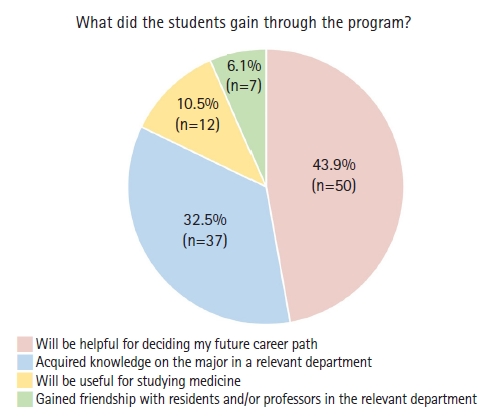
- 2,766 View
- 57 Download
-
 Abstract
Abstract
 PDF
PDF - Background
Because premed students do not take courses related to medicine during their first 2 years, they cannot establish their identity as students at medical schools, making it difficult for them to set goals as future doctors. We conducted an early clinical and basic laboratory exposure program for premed students and studied the effects of the program and student satisfaction levels.
Methods
We performed an early clinical and basic laboratory exposure program for premed students for 2 days and evaluated the effects of the program and student satisfaction with it. The program consisted of two types: type 1, where two to four students formed a group, which was assigned to a particular department to participate and make observations during ward rounds, outpatient clinics, examinations, procedures, and surgeries (in the case of basic laboratory work, the students partook in experimental observations); and type 2, where one student followed a medical school professor to observe the professor’s day. After the program ended, an online survey was conducted to investigate the effects on students, their thoughts, and satisfaction levels.
Results
In total, 114 students (91.2%) responded to the survey. Approximately 94% of them were satisfied with the program. They found that the program would be useful for deciding on future career paths, gaining knowledge about a department of interest, studying for a medical program after premedical studies, and befriending residents and professors in certain departments.
Conclusion
Early clinical and basic laboratory exposure programs are recommended for premedical students.
- A study on the mental health of students at a medical school during COVID-19 outbreak: a retrospective study
- Yu Ra Kim, Hye Jin Park, Bon-Hoon Koo, Ji Young Hwang, Young Hwan Lee
- J Yeungnam Med Sci. 2022;39(4):314-321. Published online August 16, 2022
- DOI: https://doi.org/10.12701/jyms.2022.00437
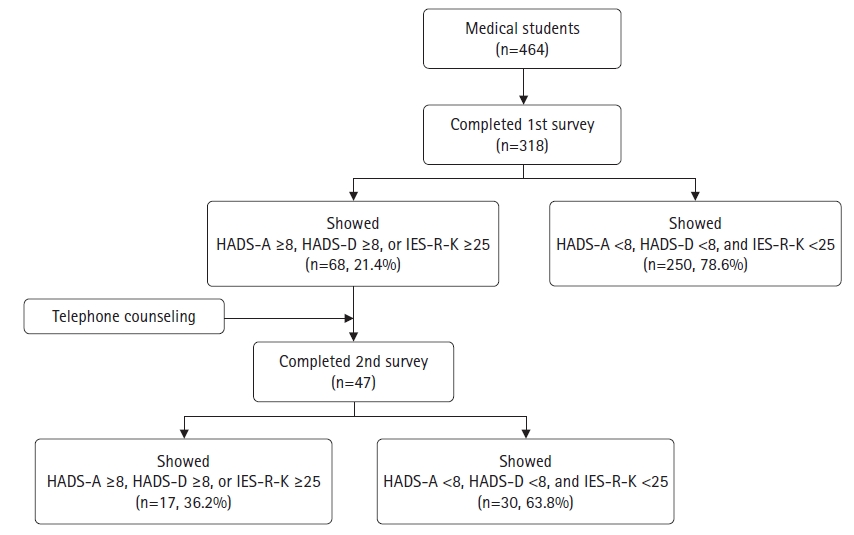
- 2,994 View
- 65 Download
- 1 Web of Science
- 2 Crossref
-
 Abstract
Abstract
 PDF
PDF - Background
In this study, the degree of anxiety, depression, and stress caused by coronavirus disease 2019 (COVID-19) was identified, as well as the need for psychological prevention measures among medical students in the Daegu region that was designated the first special disaster area due to the spread of COVID-19.
Methods
The subjects of this study were 318 medical students in Daegu who voluntarily participated in an online test using the Hospital Anxiety and Depression Scale and Impact of Event Scale-Revised Korean version. As a result of the test, risk students received immediate telephone counseling, and the effect of this telephone counseling was analyzed.
Results
There were no differences in depression, anxiety, or stress according to gender and grade. As a result of immediate telephone counseling for risk students, significant differences were found in depression, anxiety, and stress, and the counseling was found to be effective.
Conclusion
For medical students who are easily exposed to stress, the importance of psychological prevention measures and effectiveness of non-face-to-face counseling should be recognized. In the field of medical education, we must do our best to build a system that can be used immediately at the appropriate time for these programs. -
Citations
Citations to this article as recorded by- Global prevalence of anxiety and depression among medical students during the COVID-19 pandemic: a systematic review and meta-analysis
Yen-Ko Lin, Ita Daryanti Saragih, Chia-Ju Lin, Hsin-Liang Liu, Chao-Wen Chen, Yung-Sung Yeh
BMC Psychology.2024;[Epub] CrossRef - Study on the Learning Environment of Medical Students in the COVID-19
Yu Ra Kim, Hye Jin Park, Saeyoon Kim
Keimyung Medical Journal.2023; 42(2): 80. CrossRef
- Global prevalence of anxiety and depression among medical students during the COVID-19 pandemic: a systematic review and meta-analysis
- Regenerative potential of biphasic calcium phosphate and enamel matrix derivatives in the treatment of isolated interproximal intrabony defects: a randomized controlled trial
- Pritish Chandra Pal, Ashish Bali, Ramanarayana Boyapati, Sangita Show, Kanikanti Siva Tejaswi, Sourabh Khandelwal
- J Yeungnam Med Sci. 2022;39(4):322-331. Published online September 2, 2022
- DOI: https://doi.org/10.12701/jyms.2022.00325

- 3,053 View
- 82 Download
-
 Abstract
Abstract
 PDF
PDF - Background
The combined use of biomaterials for regeneration may have great biological relevance. This study aimed to compare the regenerative potential of biphasic calcium phosphate (BCP) alone and with growth factor enamel matrix derivatives (EMDs) for the regeneration of intrabony defects at 1 year.
Methods
This randomized controlled trial included 40 sites in 29 patients with stage II/III periodontitis and 2/3 wall intrabony defects that were treated with BCP alone (control group) or a combination of BCP and EMD (test group). BCP alloplastic bone grafts provide better bio-absorbability and accelerate bone formation. EMDs are commercially available amelogenins. Mean values and standard deviations were calculated for the following parameters: plaque index (PI), papillary bleeding index (PBI), vertical probing pocket depth (V-PPD), vertical clinical attachment level (V-CAL), and radiographic defect depth (RDD). Student paired and unpaired t-tests were used to compare the data from baseline to 12 months for each group and between the groups, respectively. The results were considered statistically significant at p<0.05.
Results
At 12 months, the PI and PBI scores of the control and test groups were not significantly different (p>0.05). The mean V-PPD difference, V-CAL gain, and RDD difference were statistically significant in both groups at 12 months (p<0.001 for all parameters). Intergroup comparisons showed that the mean V-PPD reduction (2.13±1.35 mm), V-CAL gain (2.53±1.2 mm), and RDD fill (1.33±1.0 mm) were statistically significant between the groups at 12 months (p<0.001 for all parameters).
Conclusion
BCP and EMDs combination is a promising modality for the regeneration of intrabony defects.
Case reports
- Recovery of the ascending reticular activating system and consciousness following comprehensive management in a patient with traumatic brain injury: a case report
- Sung Ho Jang, Young Hyeon Kwon
- J Yeungnam Med Sci. 2022;39(4):332-335. Published online August 12, 2021
- DOI: https://doi.org/10.12701/yujm.2021.01172

- 4,677 View
- 96 Download
-
 Abstract
Abstract
 PDF
PDF - We report on changes in the ascending reticular activating system (ARAS) concurrent with the recovery of impaired consciousness following rehabilitation and cranioplasty in a patient with traumatic brain injury (TBI), which were demonstrated on diffusion tensor tractography (DTT). A 34-year-old male patient was diagnosed with a traumatic intracerebral hemorrhage after falling from a height of approximately 7 m and underwent a right frontoparietotemporal decompressive craniectomy and hematoma removal. At 5 months after onset, when starting rehabilitation, the patient showed impaired consciousness, with a Glasgow Coma Scale (GCS) score of 4. Comprehensive rehabilitative therapy was provided until 14 months after onset, and his GCS score improved to 8. Cranioplasty was performed using auto-bone at 14 months after onset. One month after cranioplasty, his GCS score improved to 12. On the 15-month DTT, the deviated lower dorsal ARAS was restored on both sides, and the right side had become thicker. The right lower ventral ARAS was reconstructed, and increased neural connectivity of the upper ARAS was detected in both the prefrontal cortices. Thus, changes in the ARAS were demonstrated in a patient with TBI during recovery of consciousness following rehabilitation and cranioplasty.
- Posterior reversible encephalopathy syndrome related to anemia correction in a patient with uterine myoma: a case report
- Jisun Lee, Hyun Jung Lee
- J Yeungnam Med Sci. 2022;39(4):336-340. Published online September 23, 2021
- DOI: https://doi.org/10.12701/yujm.2021.01375

- 3,857 View
- 67 Download
- 1 Crossref
-
 Abstract
Abstract
 PDF
PDF Supplementary Material
Supplementary Material - Although posterior reversible encephalopathy syndrome (PRES) is induced by various causes, a few cases have occurred after severe anemia correction. In this case report, a 45-year-old female patient visited emergency department with a chief complaint of dizziness due to severe anemia related to hypermenorrhea caused by uterine myoma. Before her operation, she had an abrupt headache and seizure during anemia correction with transfusion and injection of gonadotropin-releasing hormone agonist. Immediately after the operation, she experienced visual disturbances, followed by limb weakness and tonic-clonic movements. Magnetic resonance imaging showed alterations in parietal and occipital lobes suggesting cerebrovascular edema with hypoperfusion. Here, we presented and discussed the clinical and radiologic features of PRES related to anemia correction.
-
Citations
Citations to this article as recorded by- Posterior Reversible Encephalopathy Syndrome (PRES) following blood transfusion in a polytrauma victim, an atypical occurrence
Erum Shariff, Nehad Mahmoud Soltan
Turkish Journal of Emergency Medicine.2024; 24(3): 180. CrossRef
- Posterior Reversible Encephalopathy Syndrome (PRES) following blood transfusion in a polytrauma victim, an atypical occurrence
- A useful method of using the healing abutments for interocclusal records in implant overdenture: a case report
- Hyunsuk Choi, Sohee Kang
- J Yeungnam Med Sci. 2022;39(4):341-343. Published online November 17, 2021
- DOI: https://doi.org/10.12701/yujm.2021.01466
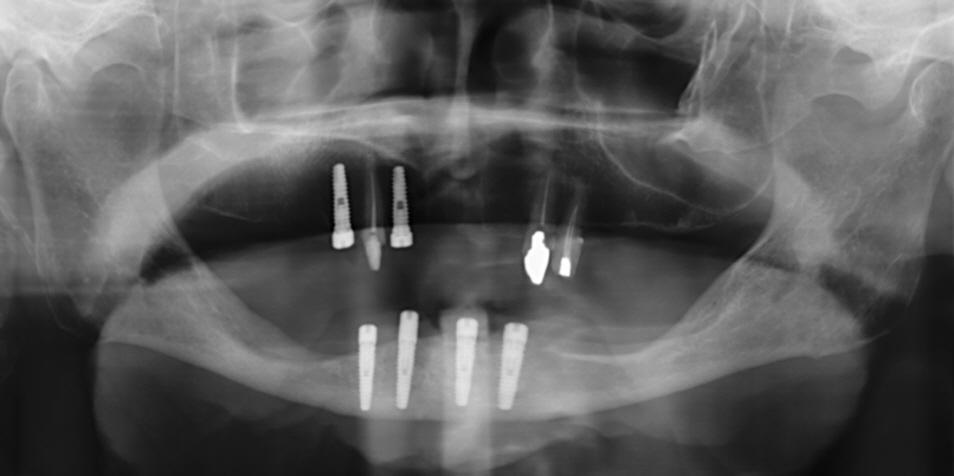
- 3,624 View
- 82 Download
-
 Abstract
Abstract
 PDF
PDF - To determine the vertical dimension and centric relation during the construction of implant overdentures, the record base and wax rim may need to be adjusted. The conventional method has several drawbacks, as it requires repeated tightening and loosening of the impression coping. Here, we report a useful and novel method for interocclusal records using the healing abutments in implant overdentures. Our case demonstrates that this method is easier and simpler and prevents gingival collapse.
Communication
- The pros and cons of entry restrictions: are entry restrictions really effective in preventing the spread of SARS-CoV-2?
- Donghwi Park, Mathieu Boudier-Revéret, Min Cheol Chang
- J Yeungnam Med Sci. 2022;39(4):344-346. Published online January 14, 2022
- DOI: https://doi.org/10.12701/yujm.2021.01599
- 3,534 View
- 85 Download
- 1 Web of Science
- 1 Crossref
-
 Abstract
Abstract
 PDF
PDF - Severe acute respiratory syndrome coronavirus 2 (SARS-CoV-2) has rapidly spread worldwide, leading the World Health Organization to declare coronavirus disease 2019 (COVID-19) a pandemic. To curb the unchecked spread of SARS-CoV-2 infection, most countries have enforced travel restrictions. However, it is debatable whether such restrictions are effective in containing infections and preventing pandemics. Rather, they may negatively impact economies and diplomatic relationships. Each government should conduct an extensive and appropriate analysis of its national economy, diplomatic status, and COVID-19 preparedness to decide whether it is best to restrict entering travelers. Even if travelers from other countries are allowed entry, extensive contact tracing is required to prevent the spread of COVID-19. In addition, governments can implement “travel bubbles,” which allow the quarantine-free flow of people among countries with relatively low levels of community transmission. An accurate evaluation of the benefits and losses due to entry restrictions during the COVID-19 pandemic would be helpful in determining whether entry restrictions are an effective measure to reduce the spread of infection in future pandemics.
-
Citations
Citations to this article as recorded by- “Exceptionally challenging time for all of us”: Qualitative study of the COVID-19 experiences of partners of diplomatic personnel
Samantha K. Brooks, Dipti Patel, Neil Greenberg, Joseph Adu
PLOS ONE.2023; 18(11): e0293557. CrossRef
- “Exceptionally challenging time for all of us”: Qualitative study of the COVID-19 experiences of partners of diplomatic personnel
Resident fellow section: Clinical vignette
- Differential diagnosis of motor weakness in the right lower limb of a 59-year-old male patient
- Jae Hwa Bae, Soyoung Kwak
- J Yeungnam Med Sci. 2022;39(4):347-351. Published online September 20, 2022
- DOI: https://doi.org/10.12701/jyms.2022.00535

- 2,755 View
- 78 Download

 E-Submission
E-Submission Yeungnam University College of Medicine
Yeungnam University College of Medicine


 First
First Prev
Prev



